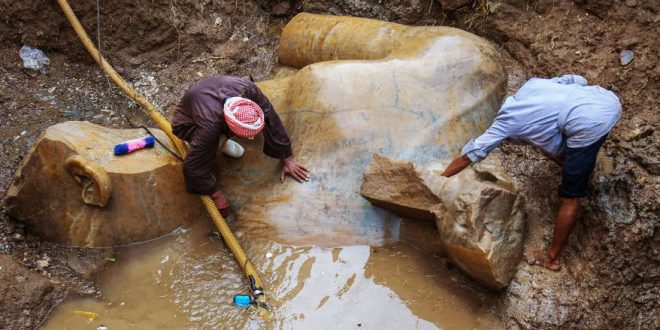Archaeologists have discovered a colossal statue, possibly depicting Egyptian pharaoh Ramses the Great, in a muddy pit in a Cairo suburb, Egypt’s antiquities ministry announced.
A remarkable find was revealed this week—literally—when a team of Egyptian and German archaeologists extracted a massive, 3,000-year-old statue, believed to represent Ramses II, from the muddy depths of an Egyptian slum.
The 26-foot-tall quartzite relic was buried beneath the streets of a residential Cairo neighborhood of Matariyyah, once the site of the ancient city of Heliopolis. Dedicated to the worship of the sun god Re, it was home to a dazzling temple complex that was destroyed during the Greco-Roman period. Many of the city’s treasures and building materials were plundered, lost or recycled for later use.
In addition to structures dedicated to Re, Heliopolis was also the site of a sun temple built by the (far from modest) Ramses II in his own honor. The location of the statue near the former entrance to that temple makes it likely that it represents the man known as “The Great Ancestor.” Ramses, also known by the Greek transliteration of his name Ozymandias (as in famed 19th century sonnet by poet Percy Shelley), was Egypt’s most powerful pharaoh, ruling for 66 years during the 19th dynasty.
The statue had long broken into massive sections, making it difficult to remove from the mud. So far, they’ve been able to extract most of the head, but the torso, for now, remains mired in the muck. As Egyptian antiquities minister Khaled al-Anani told Reuters, the team “found the bust of the statue and the lower part of the head and now we removed the head and we found the crown and the right ear and a fragment of the right eye.
That also caused a bit of controversy, too, when news reports showing the use of forklifts and heavy equipment to extract the statue from its sticky site led to anger from locals who believed the broken sections had been caused by the German-Egyptian removal team—forcing experts and Egyptologists to rush to their defense.
The international research team began digging at the site back in 2012, which had previously been difficult to examine because of how densely populated and littered with industrial waste the neighborhood was. The team will continue to excavate the site, which in addition to the probable Ramses statue has already yielded a smaller, life-sized statue of Seti II, Ramses II.
Egyptologists hope to be able to reassemble the statues in time for next year’s planned opening of the new Grand Egyptian Museum.
Agencies/Canadajournal
 Canada Journal – News of the World Articles and videos to bring you the biggest Canadian news stories from across the country every day
Canada Journal – News of the World Articles and videos to bring you the biggest Canadian news stories from across the country every day



